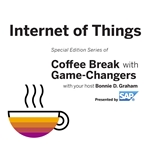
Internet of Things with Game Changers, Presented by SAP
Game-changing technology strategies are transformational, exciting and disruptive for a reason. They shake up your status quo. They get you thinking about new ways to scale, compete and grow. They move you in amazing new directions.brbr
Join host Bonnie D. Graham as she invites you to take an additional coffee break with game-changers for our special series on totally new sources of information that will change the way you run your business, on Internet of Things with Game Changers.brbr
Learn how you can become the savvy Transformation Leader who leads your company to analyze and act on the hidden data that permeates everyday business activities. Internet of Things with Game Changers, presented by SAP, can be heard live on Wednesdays at 11 AM Pacific Time / 2 PM Eastern Time on the VoiceAmerica Business Channel.
Episodios